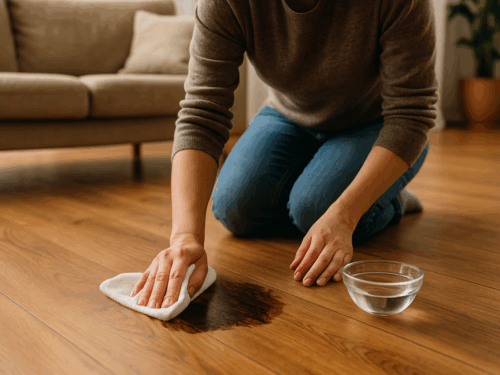
How to Remove Dark Stains from Hardwood Floors
If you’ve discovered dark spots or rings on your beautiful hardwood floors, you’re not alone. These stubborn marks — often caused by water damage, pet urine, or trapped moisture — are among the most frustrating flooring problems homeowners face.
The good news? You don’t always need to replace planks or refinish the entire floor. In many cases, you can remove dark stains from hardwood floors using a combination of gentle abrasion, deep cleaning, and spot treatments.
This guide walks you through every method — from basic DIY fixes to professional restoration — so you can bring your floors back to life without the guesswork.
First, Identify the Cause of the Stain
Before you grab a scrub brush, it’s important to understand what caused the dark spot. Different stains require different treatments.
Common Causes of Dark Floor Stains:
- Water damage – Usually from spills, leaks, wet mopping, or plant pots
- Pet urine – Acids and ammonia can discolor and sink into wood fibers
- Mold or mildew – Common in humid environments or under rugs
- Heat damage – Such as burn marks from dropped items or candles
Once you know the cause, you’ll be able to choose the right cleaning method and avoid damaging the wood further.
Step-by-Step Methods to Remove Dark Stains from Hardwood
1. Start with a Surface Clean
Sometimes a stain looks darker than it is because it’s mixed with grime, dust, or polish buildup. Start by gently cleaning the area:
- Mix a few drops of dish soap in warm water
- Dampen a soft cloth or sponge (do not soak!)
- Gently wipe the area and dry immediately
If the spot lightens up — congrats! If not, move on to the next level.
2. Try Hydrogen Peroxide (Great for Pet or Water Stains)
This is one of the most effective DIY methods for lifting dark stains:
- Use 3% hydrogen peroxide (available at any drugstore)
- Soak a cotton ball or paper towel in peroxide
- Place it on the stain and cover with plastic wrap
- Let sit for 4–8 hours
- Remove and let dry completely
Important: Test on a hidden spot first. Peroxide can lighten the wood color slightly, so you may need to touch up with stain afterward.
3. Baking Soda & Water Paste
For organic stains like food, plant runoff, or surface-level water damage, baking soda can work:
- Mix baking soda and water into a thick paste
- Gently apply to the stain using a soft cloth
- Rub in small circles for 2–3 minutes
- Wipe clean and dry
This method is gentle and safe for most sealed hardwood — though it may be less effective on deep-set stains.
4. White Vinegar (Use With Caution)
Vinegar is a popular cleaning solution, but it’s acidic and can damage hardwood finishes if overused. If you go this route:
- Dilute 1 part white vinegar with 2 parts water
- Lightly apply with a microfiber cloth
- Wipe clean and dry immediately
Never leave vinegar sitting on the wood — it can dull or strip the finish over time.
5. Sand and Re-Stain (For Deep or Set-In Marks)
If the stain has penetrated below the finish and into the wood grain, you’ll likely need to sand the area:
- Use 100–150 grit sandpaper to gently sand the affected plank
- Wipe away dust with a damp cloth
- Apply matching stain using a small brush or rag
- Seal with polyurethane or your floor’s existing topcoat
This is the most labor-intensive method — but it’s also the most permanent solution for tough, dark stains.
Bonus Tips: Preventing Future Stains
- Use protective pads under plant pots and furniture
- Clean pet accidents ASAP
- Keep humidity in check (aim for 40–60%)
- Lay down rugs in high-risk areas (but don’t forget to clean under them!)
We also break down more cleaning strategies in our post on Flooring Myths That Might Be Ruining Your Cleaning Routine.
When to Call a Pro
If the stain spans multiple boards, keeps coming back, or if the floor is buckling or soft, it’s time to bring in a flooring specialist. You may be dealing with:
- Subfloor moisture issues
- Mold growth
- Structural damage from long-term leaks
A professional can evaluate the situation and determine if sanding, board replacement, or sealing is needed.
Final Thoughts
Dark stains on hardwood floors might seem permanent — but in most cases, they’re treatable with a little time and patience. Whether you use hydrogen peroxide, baking soda, or sandpaper, the key is to match the method to the type of stain and floor finish.
Still unsure? Browse our other helpful flooring guides like What to Do If Your Flooring Gets Water Damage or explore Slip-Resistant Flooring Options if safety is your top concern.
Walk The Plank may not refinish floors, but we know a thing or two about keeping them beautiful. Follow our blog for more tips and honest answers to all your flooring questions.


